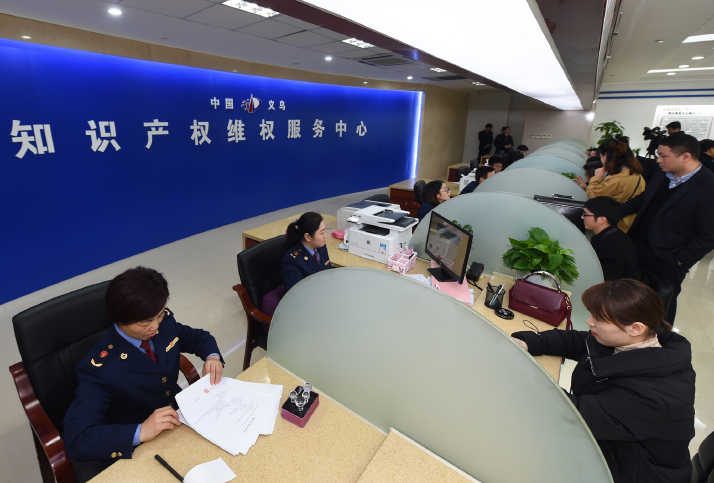| Business |
| New IPR Report Tracks Chinese Regional Leaders | |
| Chinese cities and provinces vary in IPR development | |
|
|
 Staff members provide services at the Intellectual Property Rights Protection Center in Yiwu, east China's Zhejiang Province, on November 21 (XINHUA)
Beijing Municipality, Guangdong and Jiangsu provinces ranked the top three on the Intellectual Property Rights (IPR) Index, according to an IPR report released by Globe-Law Lawyers, a professional IPR law firm, on December 17 in Beijing. While China's capital remained number one for nine consecutive years since 2010, Jiangsu fell behind its northern counterpart, Guangdong, after four-year winning streak since 2014. Guangdong's index rose from 0.482 to 0.536 in 2018, which can be attributed to the construction of the Guangdong-Hong Kong-Macao Greater Bay Area, the report said. In 2017, the number of invention patents in the bay area reached more than 176,000, surpassing that of the aggregation of the other three bay areas in the world, according to a report released in October by a research institute in Guangdong. Nationwide, the index in south, north and central China outperformed that of China's southwest, northeast and northwest regions. Wang Zhengzhi, senior partner with Globe-Law, said there was a positive correlation between IPR and regional economic development, adding that the business and ecological environments have become the two major factors confining IPR development in the central and western parts of the country. At the Boao Forum for Asia Annual Conference 2018, President Xi Jinping said China will strengthen protection of IPR. "Stronger IPR protection is the requirement of foreign enterprises, and even more so of Chinese enterprises," said Xi. China places great importance on IPR, especially since it is where innovation incubates. In October, Chief Justice of the Supreme People's Court (SPC) Zhou Qiang said that the SPC will establish a national appeals court for civil and administrative IPR cases. "A national IPR appeals court will also help nurture a favorable legal environment for technological innovation and a better business environment for domestic and international enterprises," Zhou added. "The move will help to streamline criteria for judgment," Zhao Rui, a partner with Globe-Law, said. "Policies also have been released in succession to solve the problems of low compensation, difficulties in offering testimony and the long period of judicial review." Although China has made great progress in IPR protection, Liu Zhao, professor at the IPR School at the University of the Chinese Academy of Science, said there is a need to satisfy Chinese-style innovation. China's new business model, born during the Internet era, is also in need of IPR protection, where not only technologies, but also non-technology-driven models should be taken into account. The index was calculated based on an economic model created by Globe-Law, which monitors indicators such as the output level, liquidity, comprehensive performance and creation potential of IPR in different Chinese regions. This year marks the 10th anniversary of the report which has been released since 2009. (Note: Indexes in the 2018 report are based on data in 2017, 2016 and 2015.) Copyedited by Rebeca Toledo Comments to zhangshsh@bjreview.com |
|
||||||||||||||||||||||||||||||
|